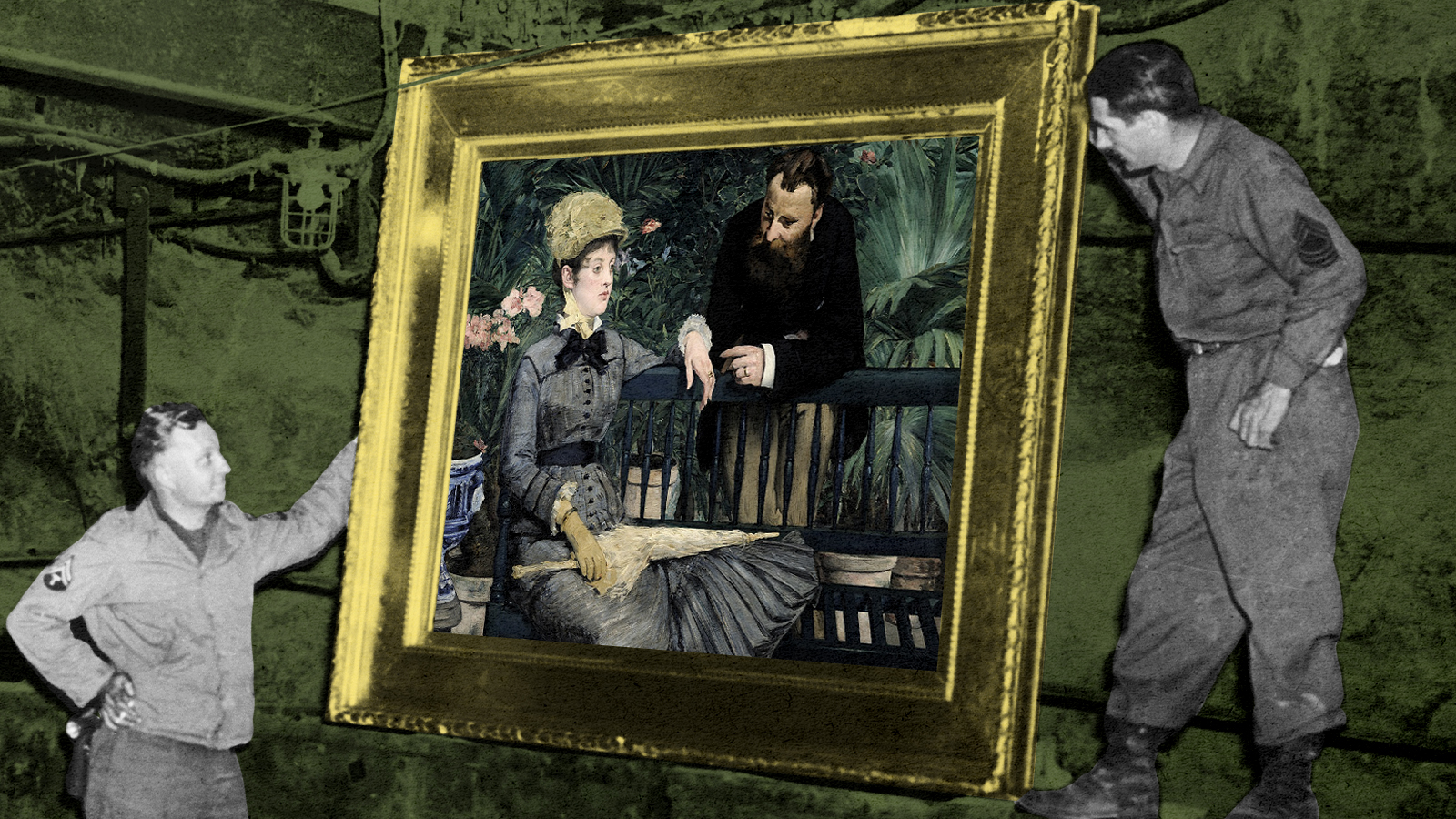New York's new Nazi stolen art law, explained
Museums will be required to acknowledge the history of their artwork


Some art displayed in New York museums will now come with a metaphorical swastika attached.
Under a new state law, museums in New York are now required to display signs alongside pre-1945 artworks "that are known to have been stolen or forcibly sold under Nazi rule," Julianne McShane reports for NBC News. Those works must also be listed with the Art Loss Register, a database of "lost, stolen and looted art."
Advocates for the new law say it will help preserve the memory of the Holocaust at a moment when the last survivors are passing from the scene. "With the history of the Holocaust being so important to pass on to the next generation, it's vital that we be transparent and ensure that anyone viewing artwork stolen by the Nazis understand where it came from and its role in history," said state Senator Anna M. Kaplan (D). How did Nazi-looted art end up in American museums? Here's everything you need to know.
The Week
Escape your echo chamber. Get the facts behind the news, plus analysis from multiple perspectives.

Sign up for The Week's Free Newsletters
From our morning news briefing to a weekly Good News Newsletter, get the best of The Week delivered directly to your inbox.
From our morning news briefing to a weekly Good News Newsletter, get the best of The Week delivered directly to your inbox.
Why and how did Nazis steal art from Europe's Jews?
The Nazis were greedy, for starters, but the story is rooted — of course — in their brutal anti-Semitism. "The looting was not only designed to enrich the Third Reich but also integral to the Holocaust's goal of eliminating all vestiges of Jewish identity and culture," Stuart E. Eizenstat wrote in 2019 for The Washington Post.
Not all the art was stolen in the usual fashion. Instead, Jews under the Nazi regime were first "encouraged" and then ultimately forced to sell their assets — including their businesses — to non-Jews under a process known as Aryanization. Art ended up being among the major assets that were forcibly sold. "Jews owned many of the well-known art houses, and some were art dealers," Anne Rothfield wrote in 2002 for Prologue Magazine. While some of the art went into the hands of private buyers, much of it was sold to buyers in neutral countries "to raise capital for purchasing additional art pieces and to purchase materials for the Nazi war machine."
The size of the theft was stunning: By the end of World War II, an estimated 650,000 pieces of art were looted from their original owners by Nazis as they plundered the continent. "It was the greatest art theft in history," Alex Shoumatoff wrote for Vanity Fair in 2014. By 2019, around 100,000 of those pieces were still missing.
How did that art find its way to American collections?
After the war ended, the stolen art only occasionally ended up back in the hands of the original owners or their heirs. Instead, many pieces were "scattered around the globe, in the possession of museums, governmental institutions and private collectors," according to a 2006 report prepared for a pair of Jewish organizations. The U.S. was no exception: As art found its way into American collections during the postwar years "it was not standard practice for museum collectors and dealers to investigate the provenance of works" they acquired. As a result, "it is clear that a significant number of works with questionable provenance entered both public and private collections in the United States." Even the most famous museums in the world — and in America — collected such works. "The Louvre, for example, holds around 1,700 Nazi-looted works of art," Ella Feldman writes for Smithsonian Magazine.
A free daily email with the biggest news stories of the day – and the best features from TheWeek.com
Some of that art was featured in an exhibition last year at New York's Jewish Museum, featuring "one extraordinary canvas after another by Pierre Bonnard, Marc Chagall, Paul Cézanne, Henri Matisse, Camille Pissarro and other great European modernist painters, each with a story to tell of pillage by the Nazi regime," Diane Cole wrote in a review for BBC. There were also "delicately crafted ritual silver objects that once graced the homes and synagogues of the Jews of Europe."
Why hasn't the art simply been returned?
It's only in the last few decades that there has been a serious effort to return looted art to the heirs of the original owners. In 1998, 44 countries signed onto the "Washington Principles," a set of guidelines for "identifying, publishing and ultimately restoring the looted art through negotiation," Eizenstat, who helped negotiate the agreement, wrote in his 2019 piece. The result? "During the past 20 years, galleries, dealers and museums began researching paintings that had passed through European hands between 1933 and 1945 to spot suspicious gaps in their provenance or chain of ownership."
Sometimes American museums have returned art — and sometimes they've fought efforts to force their hand. In 2009, the Museum of Modern Art and the Guggenheim Museum filed a lawsuit to resolve an ownership claim over two Picassos that had been forcibly sold by the original owner. (Under a settlement, the museums kept the pieces.) In 2019, a court ruled the Metropolitan Museum of Art could keep Picasso's The Actor, which was similarly sold under duress. "It is exceedingly rare … for museums to initiate 'just and fair solutions' when likely heirs are identified," Elizabeth Campbell wrote for the Center for Art Collection Ethics in 2019.
This means the new New York law might be only a half step toward righting one of the wrongs the Nazis committed 80 years ago. "Not only was [the Holocaust] the largest, most sophisticated industrial genocide of Jewish people, it was also the greatest theft in the history of the world," Greg Schneider, executive vice president at the Claims Conference, told CNN. The new law elevates the effort "to put pressure on museums to do the research, to establish the chain of ownership" and to eventually restore the stolen art to its rightful owners.
Joel Mathis is a writer with 30 years of newspaper and online journalism experience. His work also regularly appears in National Geographic and The Kansas City Star. His awards include best online commentary at the Online News Association and (twice) at the City and Regional Magazine Association.
-
 Political cartoons for December 7
Political cartoons for December 7Cartoons Sunday’s political cartoons include the Trump-tanic, AI Santa, and the search for a moderate Republican
-
 Trump’s poll collapse: can he stop the slide?
Trump’s poll collapse: can he stop the slide?Talking Point President who promised to ease cost-of-living has found that US economic woes can’t be solved ‘via executive fiat’
-
 Sudoku hard: December 7, 2025
Sudoku hard: December 7, 2025The daily hard sudoku puzzle from The Week
-
 Why photo booths are enjoying a revival
Why photo booths are enjoying a revivalIn The Spotlight It’s 100 years since it first appeared, but the photo booth is far from an analogue relic
-
 Black Rabbit: slick crime thriller set in a high-end New York restaurant
Black Rabbit: slick crime thriller set in a high-end New York restaurantThe Week Recommends Two Manhattan brothers resort to ‘ever-more high-stakes’ schemes to tackle ‘huge’ gambling debts in the ‘glossy’ series
-
 Say farewell to summer at these underrated US lakes
Say farewell to summer at these underrated US lakesThe Week Recommends Have one last blast
-
 5 fun cycling tours that let you vacation on two wheels
5 fun cycling tours that let you vacation on two wheelsThe Week Recommends Gain a new perspective while pedaling
-
 5 cultural and scenic trails to wander on four wheels
5 cultural and scenic trails to wander on four wheelsThe Week Recommends Leave the hiking shoes at home
-
 Not every hike has to wipe you out. These 7 treks are easy-breezy.
Not every hike has to wipe you out. These 7 treks are easy-breezy.The Week Recommends These trails won't leave you breathless
-
 Food trails are the best trails. Eat your way across the US with these 7 regional food journeys.
Food trails are the best trails. Eat your way across the US with these 7 regional food journeys.The Week Recommends Take a bite out of the United States
-
 Sex, drugs and a royal ruckus: the US play with a future gay Prince George
Sex, drugs and a royal ruckus: the US play with a future gay Prince GeorgeTalking Point The controversial off-Broadway show is a hit with audiences in New York
